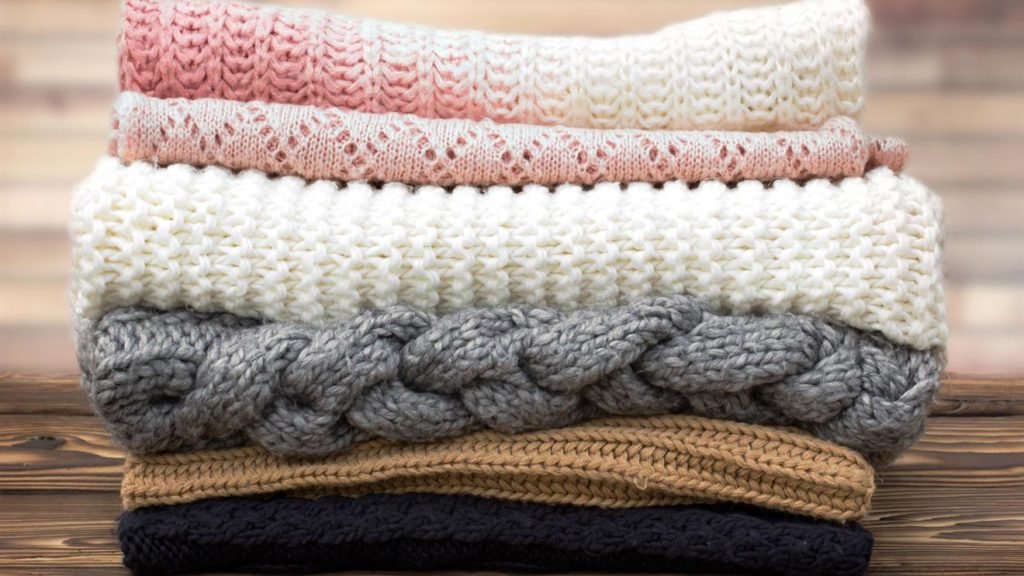Sweater Weather: How to Choose

Sweaters are made of Natural and synthetic fiber. Natural fibers look better, feel better, and last longer but they are more costly.
Materials
Wool: More specifically, sheep wool is the most common fabric used for making sweaters. There are varying grades of wool , which directly influences the softness, and warmth of the sweater.
Merino, Shetland, and Lambswool are the most common types of wool. Merino offers the softest of sweaters. Lambswool is a close second followed by Shetland. Most sweaters that are itchy are made of coarse wool. More than likely Shetland. It’s often more expensive and harder to clean than cotton.
Cashmere: If you’re going for luxury, cashmere is a high-end natural fiber that comes from certain breeds of goats. It’s one of the best materials in terms of warmth and softness, and most people find it to be less itchy than wool thanks to its finer fibers. However, cashmere sweaters are often quite expensive and they require specific care.
One of the most expensive sweater materials doesn’t come from a sheep. Instead, cashmere comes from a goat. It is made from the soft undercoat of cashmere goats. Cashmere is notably soft, lightweight, and warm.
Cotton: Is a natural plant-based fiber grown all around the world and used to make a variety of clothing. Cotton fibers are soft, strong, absorbent, easy to wash, and affordable, making this material a popular choice for sweaters.
After wool, cotton is the next most common type of material used to make sweaters. Cotton, despite being soft and lightweight, is durable and cool. Given its lightweight attributes it is best to wear cotton sweaters in spring or summer when the nights get chilly.
Silk: 100% silk sweaters are not common. Instead adding silk to the sweater knit adds extra insulation. Silk is soft yet durable and it retains heat (hence the insulation).
Linen: Linen is light, it’s breathable, and it helps to keep you cool. It’s a great choice for warm weather. The only possible drawback is that linen wrinkles easily.
Acrylic: Acrylic is a synthetic fiber that imitates many of the desirable qualities of wool at a lower price. It’s lightweight, soft, and warm, and it can be manufactured to resemble fur, making it a popular fiber for faux-fur vests.
Specialty fibers: You may also encounter sweaters made from specialty fibers, such as alpaca or angora. Both of these natural, animal-based fibers have similar properties to wool.
Fiber blends: It’s common to see sweaters made from a blend of fibers, such as cotton and wool, which give you the best characteristics from both materials.
Types Of Sweater Knits
Sweaters are most often made from knitted fabric, as opposed to woven materials. Knitted fabrics are stretchier and less prone to wrinkles, and different knitted patterns can be used to create interesting textures and styles.
Traditional: If you’ve ever tried knitting, you’re probably familiar with a traditional knit pattern. This type of fabric uses one thread to form a series of interconnected loops, and there are several stitches that can be used to create different patterns.
Ribbed: Have you ever noticed how the cuffs on most sweaters are a different stitch pattern? This striped pattern is called a ribbed knit, and it creates a tighter, stretchier fabric.
Bouclé Knit: A bouclé knit is actually just a traditional knit made with bouclé yarn, which winds together several strands of yarn at different tensions for a loopy appearance. Bouclé knits have a unique textured appearance and are generally quite thick and cozy.
Cable Knit: This knit is popular for sweaters because of its classic, elegant appearance. In this type of knit, there’s a distinct pattern—often resembling some sort of braid or plait—that runs the length of the fabric.
Different Sweater Silhouettes
All these materials and types of knits can be used to create a variety of sweater styles, ranging from traditional crew necks to more trendy cold-shoulder sweaters.
Turtlenecks: Turtlenecks have been around for years, earning their place as a wardrobe staple for many women. These distinctive sweaters feature a tight collar that covers your neck for extra warmth.
Crew or round necks: Another timeless style, crew- or round-neck sweaters have a circular neckline that encircles the neck.
V-necks: As their name suggests, V-neck sweaters have a V-shaped neckline that makes them perfect for showing a little more skin or pairing with a necklace.
Cardigans: Cardigans are recognizable by their open fronts—some have buttons that allow you to close them, while others have waist ties or no closure at all. As such, cardigans are a popular option for layering.
Dusters: Dusters are longer cardigans that often reach the thigh or even the knee.
Fashion styles: Depending on the current season, there are typically several trendy sweater styles. Some recent trends include cold-shoulder sweaters, which have cutouts on the shoulders, and choker sweaters, which feature a V-shaped neckline with a strip of fabric across the neck.



